Tired of boring patio steps that look like an afterthought? You're not alone. Most homeowners struggle with creating steps that actually enhance their outdoor space instead of just getting you from point A to point B. The good news? There are tons of creative ways to turn those functional necessities into stunning focal points. From sleek floating concrete to rustic fieldstone with built-in planters, we've rounded up 20 brilliant ideas that prove safety and style can absolutely go hand in hand. Let's dive into some serious step inspiration.
1. Natural Stone Patio Steps with Granite Treads

Among the most enduring choices for outdoor steps, natural granite patio steps offer unmatched durability and timeless elegance. These steps feature thick granite slabs as treads, typically measuring 6 inches thick and 18-20 inches wide, creating substantial footing that feels secure underfoot. The natural variations in granite colors—from deep charcoal and blue-gray to warm amber and pink tones—ensure each installation is unique. Consider incorporating weathered granite with natural cleft faces for rustic appeal, or opt for thermal-finished granite for a more refined, contemporary look. The inherent strength of granite makes these steps perfect for high-traffic areas, while their natural slip resistance provides safety in wet conditions.
2. Modern Floating Concrete Patio Steps
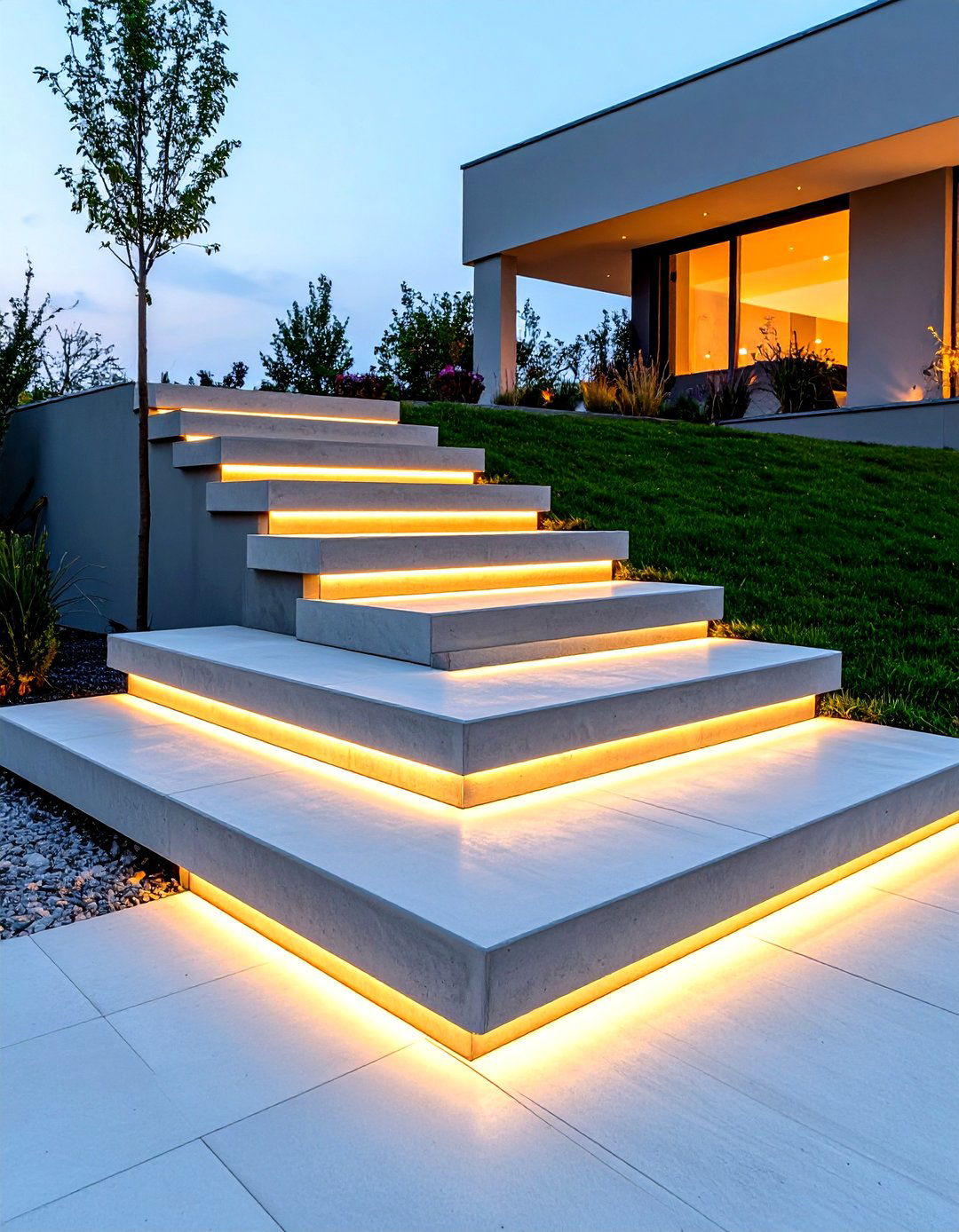
Floating concrete patio steps create a striking contemporary statement with their minimalist design and clean lines. These steps appear to hover above the ground through concealed structural supports, creating an illusion of weightlessness that works beautifully in modern landscape designs. The concrete can be finished in various textures—from smooth polished surfaces to brushed or exposed aggregate finishes that add visual interest and slip resistance. Integrated LED strip lighting underneath each tread enhances the floating effect while providing safe navigation at night. This design works particularly well when paired with minimalist landscaping, geometric plantings, or architectural homes with clean, modern lines.
3. Traditional Brick Patio Steps with Herringbone Pattern
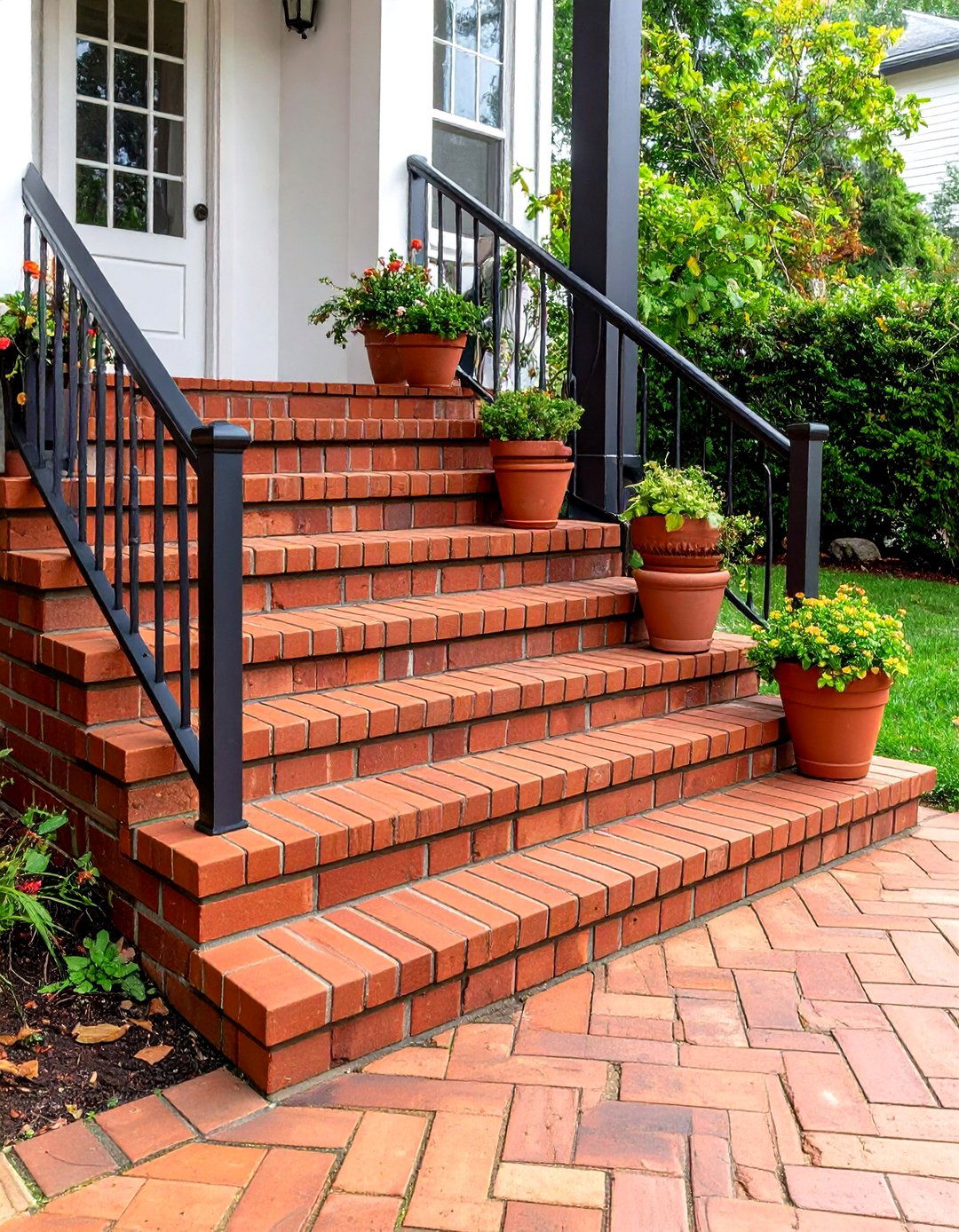
Traditional brick patio steps bring classic charm and warmth to any outdoor space through their rich, earthy colors and timeless appeal. The herringbone pattern adds visual interest and creates a sophisticated look that complements both traditional and transitional home styles. Using clay bricks in varying shades of red, brown, and even weathered gray creates depth and character that only improves with age. The steps can be constructed with solid brick risers and treads, or combine brick with stone caps for added elegance. Proper mortar joints and drainage are essential for longevity, while the modular nature of bricks allows for easy repairs if needed.
4. Curved Patio Steps with Integrated Planters

Curved patio steps with integrated planters create a softer, more organic approach to level changes while adding living elements directly into the step design. These steps follow gentle curves that mirror natural landscape contours, making them feel like a seamless part of the garden rather than an imposed structure. Built-in planters can be incorporated between step runs or along the edges, allowing for seasonal displays of flowers, herbs, or decorative grasses. The curved design requires careful planning and skilled construction, often using flexible materials like concrete or carefully cut stone. This approach works beautifully in gardens with flowing, naturalistic designs and helps blur the lines between hardscape and softscape elements.
5. Wide Cascading Patio Steps with Stone Veneer

Wide cascading patio steps create a grand, welcoming entrance that makes a bold architectural statement. These steps feature generous 36-inch deep treads and span the full width of the patio area, creating multiple pathways and natural gathering spots. Stone veneer on the risers—whether natural fieldstone, manufactured stone, or stacked slate—adds texture and visual weight while keeping costs more reasonable than solid stone construction. The wide design allows for decorative elements like planters, lighting, or even built-in seating areas. This style works particularly well for large patios or when connecting significant elevation changes between a home and garden areas.
6. Timber Sleeper Patio Steps with Gravel Infill
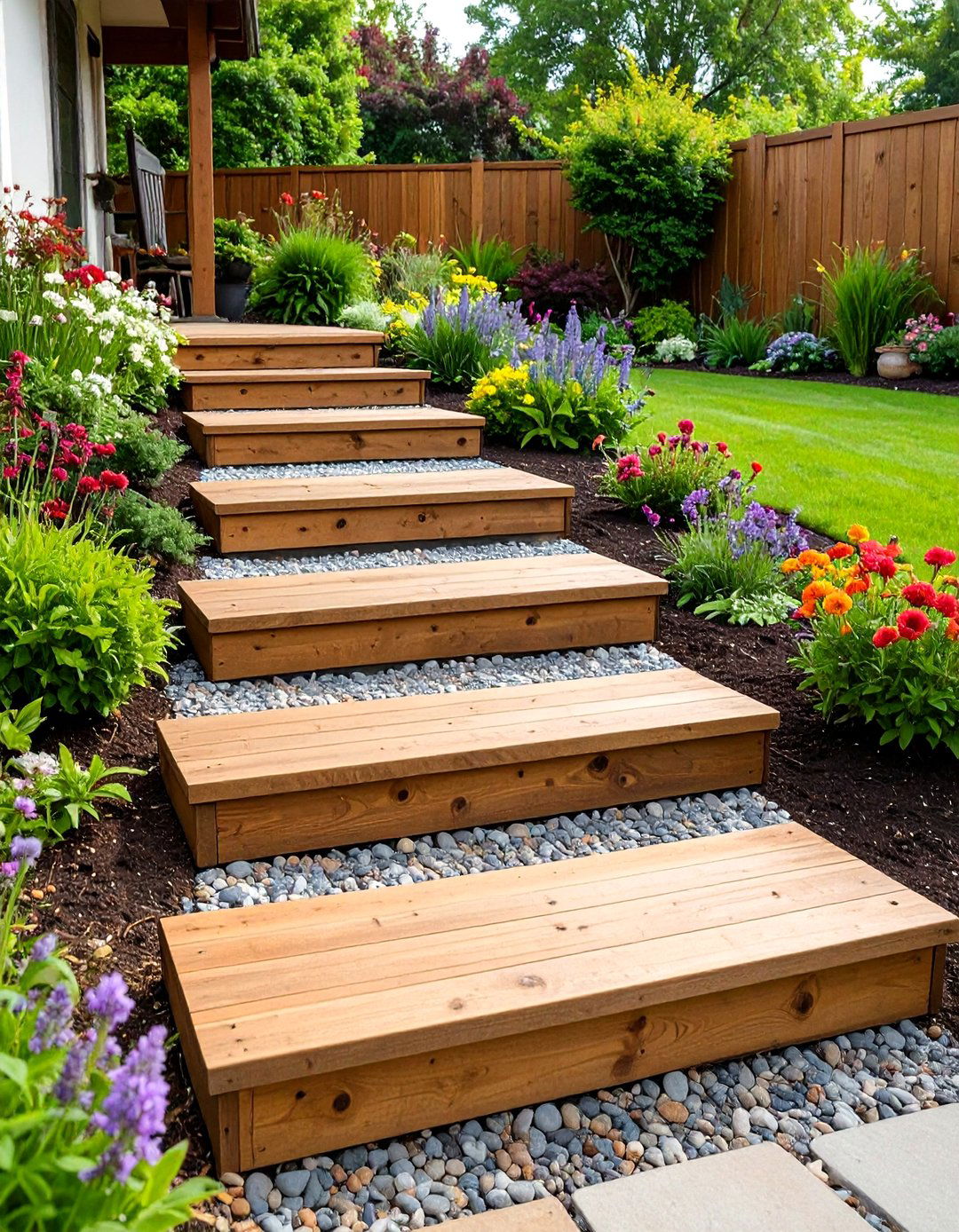
Timber sleeper patio steps offer a rustic, natural aesthetic that blends beautifully with informal garden settings. Using thick, treated timber sleepers as risers creates substantial, earthy steps that age gracefully over time. The treads can be filled with well-draining gravel, crushed stone, or even permeable materials that allow water to filter through naturally. This construction method is relatively budget-friendly and can be adapted to various slope conditions. The natural wood tones complement plantings beautifully, and the steps can be enhanced with integrated lighting or bordered with low-growing plants. Regular maintenance includes checking for settling and occasionally refreshing the gravel surface.
7. Paver Patio Steps with Contrasting Borders
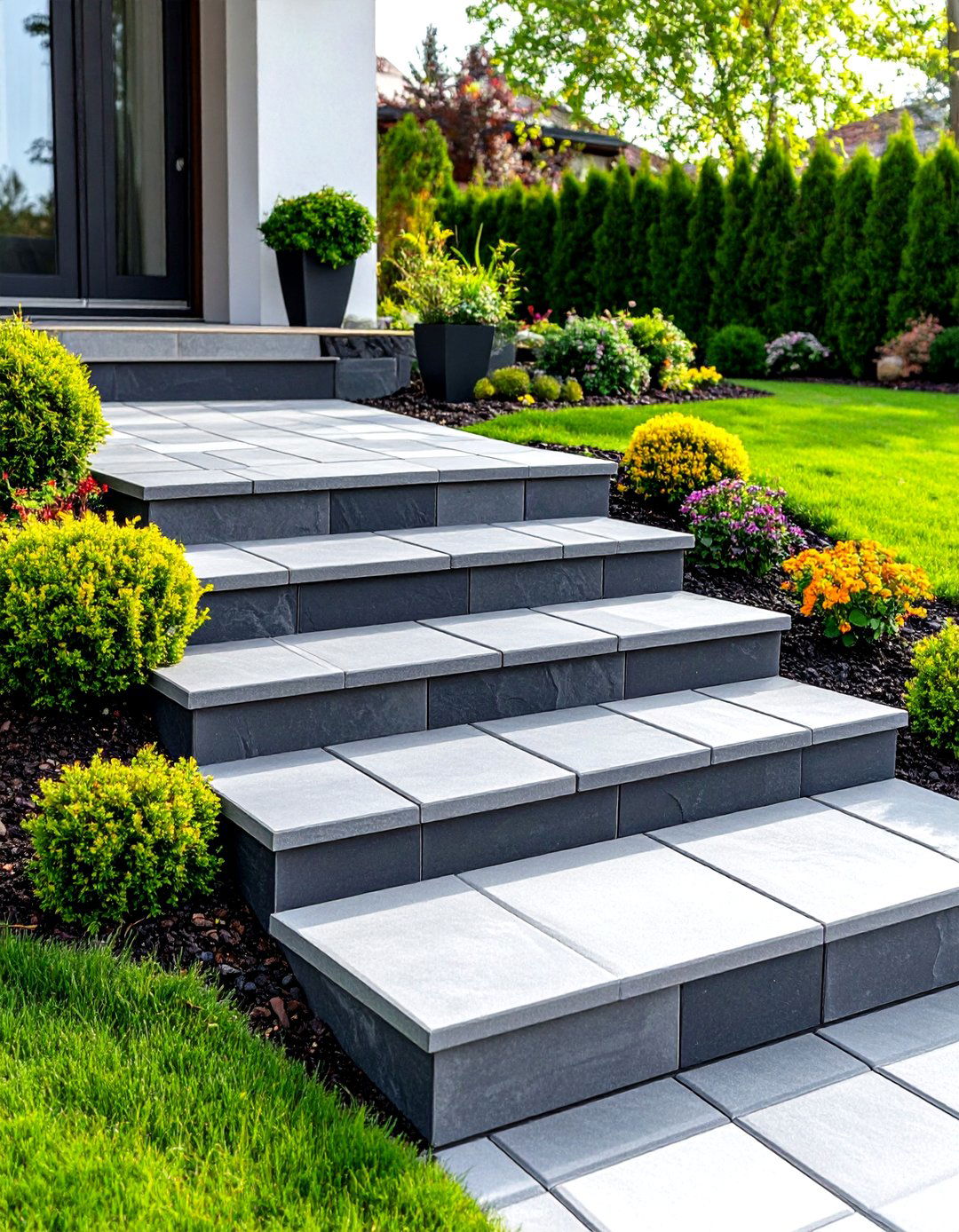
Paver patio steps offer incredible versatility in colors, patterns, and textures while maintaining excellent durability and relatively simple installation. Using contrasting borders—such as dark charcoal pavers framing lighter gray centers, or brick borders around concrete pavers—creates visual definition and sophisticated detail. The modular nature of pavers allows for creative patterns like running bond, basket weave, or soldier courses. Proper base preparation with compacted gravel and sand leveling ensures long-term stability. This approach works well for both contemporary and traditional designs, and the individual pavers can be easily replaced if damaged, making maintenance straightforward.
8. Bluestone Patio Steps with Natural Cleft Finish
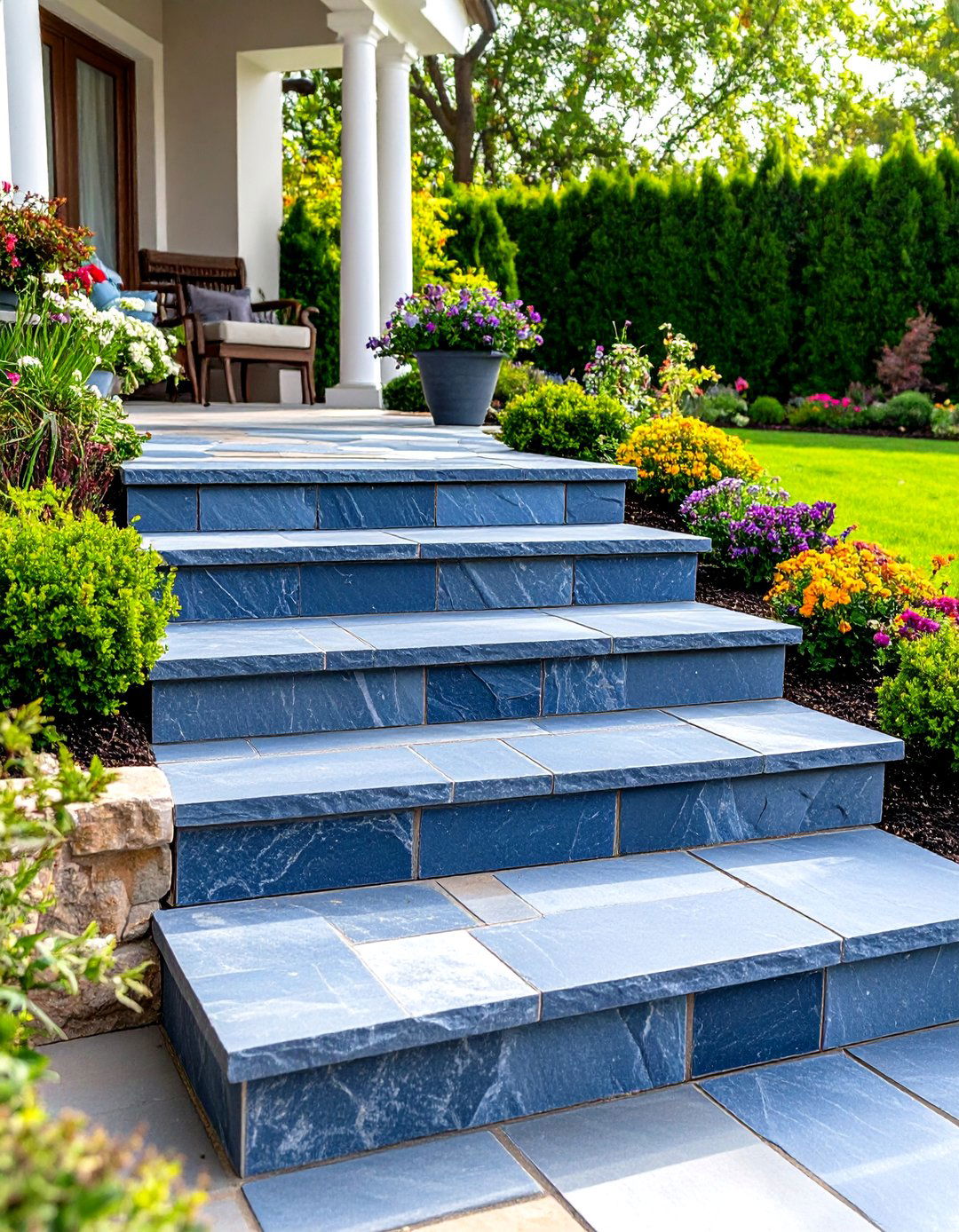
Bluestone patio steps provide a perfect balance of elegance and durability, featuring the stone's characteristic blue-gray color with natural variation and subtle earth tones. The natural cleft finish offers excellent slip resistance while showcasing the stone's inherent beauty and texture. Bluestone steps can be cut to precise dimensions for formal installations or left with natural edges for a more rustic appearance. The dense, fine-grained structure of bluestone makes it ideal for outdoor use in all climates. These steps pair beautifully with both traditional and contemporary architecture, and their neutral coloring works well with virtually any landscape design or plant palette.
9. Terraced Patio Steps with Built-in Seating
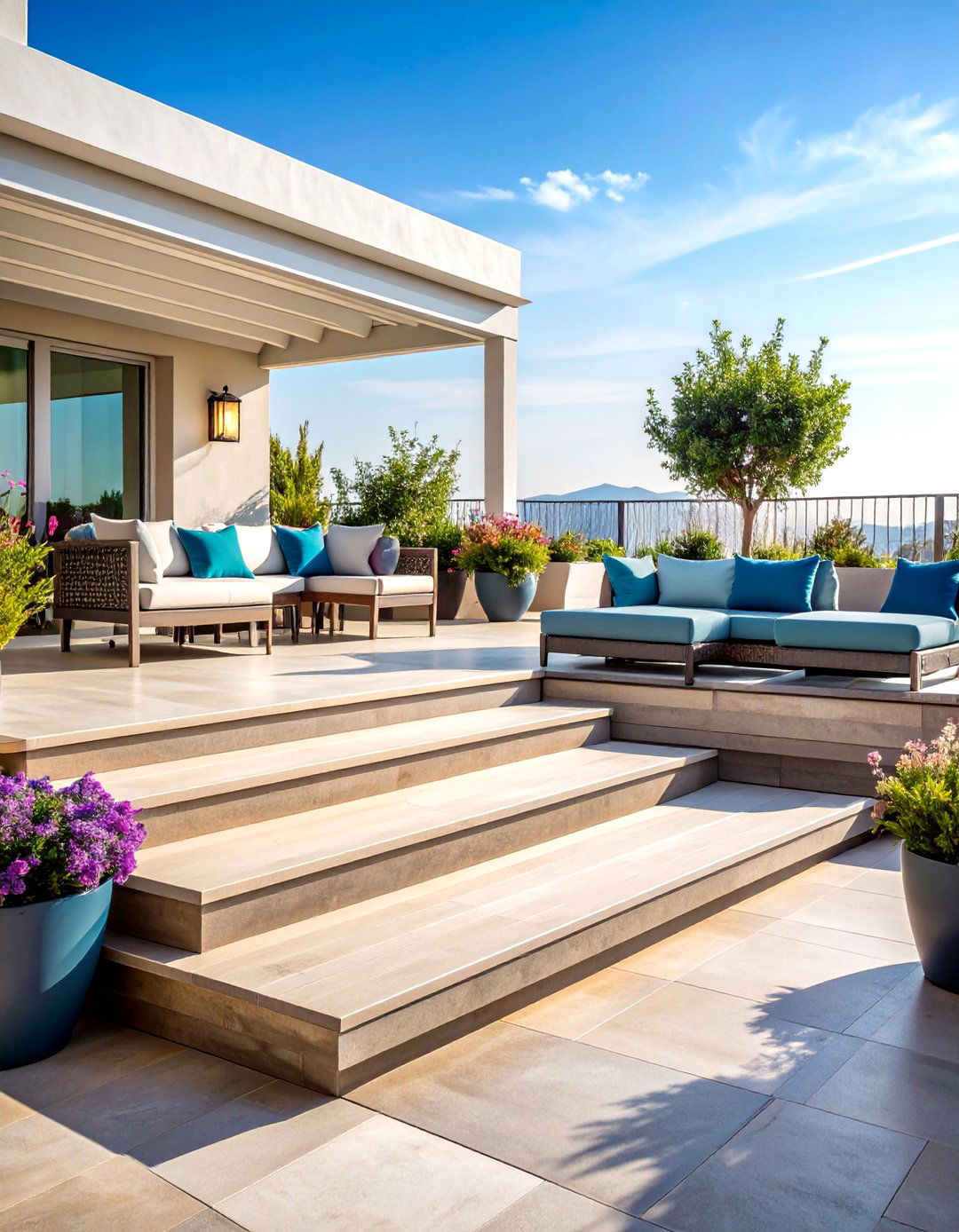
Terraced patio steps with built-in seating maximize functionality while creating intimate spaces for relaxation and conversation. This design incorporates wider landings at regular intervals, with extended sections that serve as comfortable seating areas. The seating can be constructed from the same materials as the steps for continuity, or contrasting materials for visual interest. Cushions and pillows can be added for comfort, while integrated planters or lighting enhance the ambiance. This approach works particularly well for steep slopes where traditional steps might feel too abrupt, and it creates natural gathering spots for entertaining or quiet contemplation.
10. Illuminated Patio Steps with LED Integration
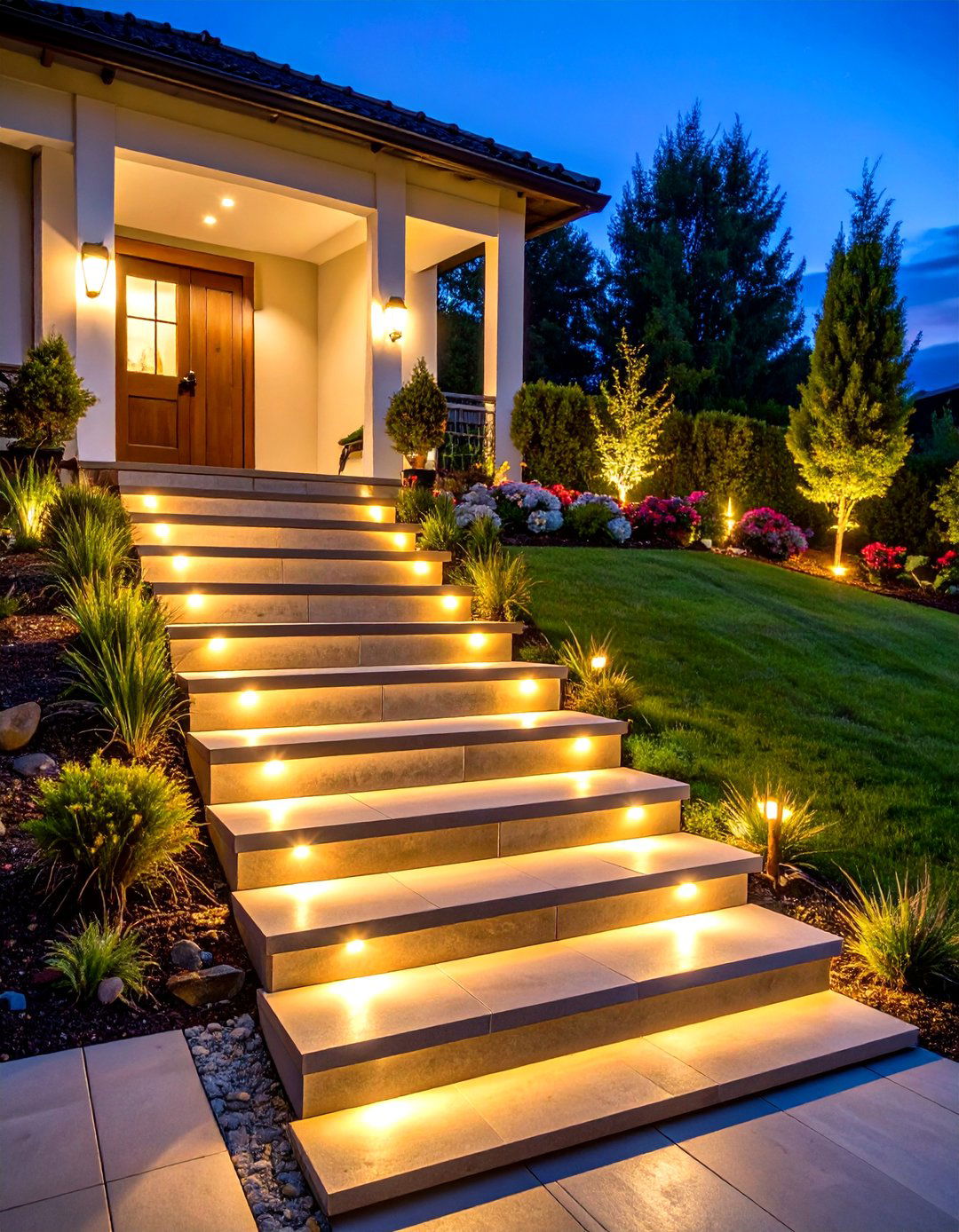
Illuminated patio steps combine safety with stunning visual impact through carefully planned LED lighting integration. Lights can be recessed into step risers, embedded in treads, or installed as strip lighting along the edges. Warm white LED lights create a welcoming atmosphere while providing clear visibility for safe navigation. The lighting can be controlled with timers, motion sensors, or smart home integration for convenience and energy efficiency. Low-voltage LED systems are safe and cost-effective to operate. This feature works with virtually any step material and design, from contemporary concrete to traditional stone, adding a luxury hotel-like ambiance to outdoor spaces.
11. Mixed Material Patio Steps with Wood and Steel
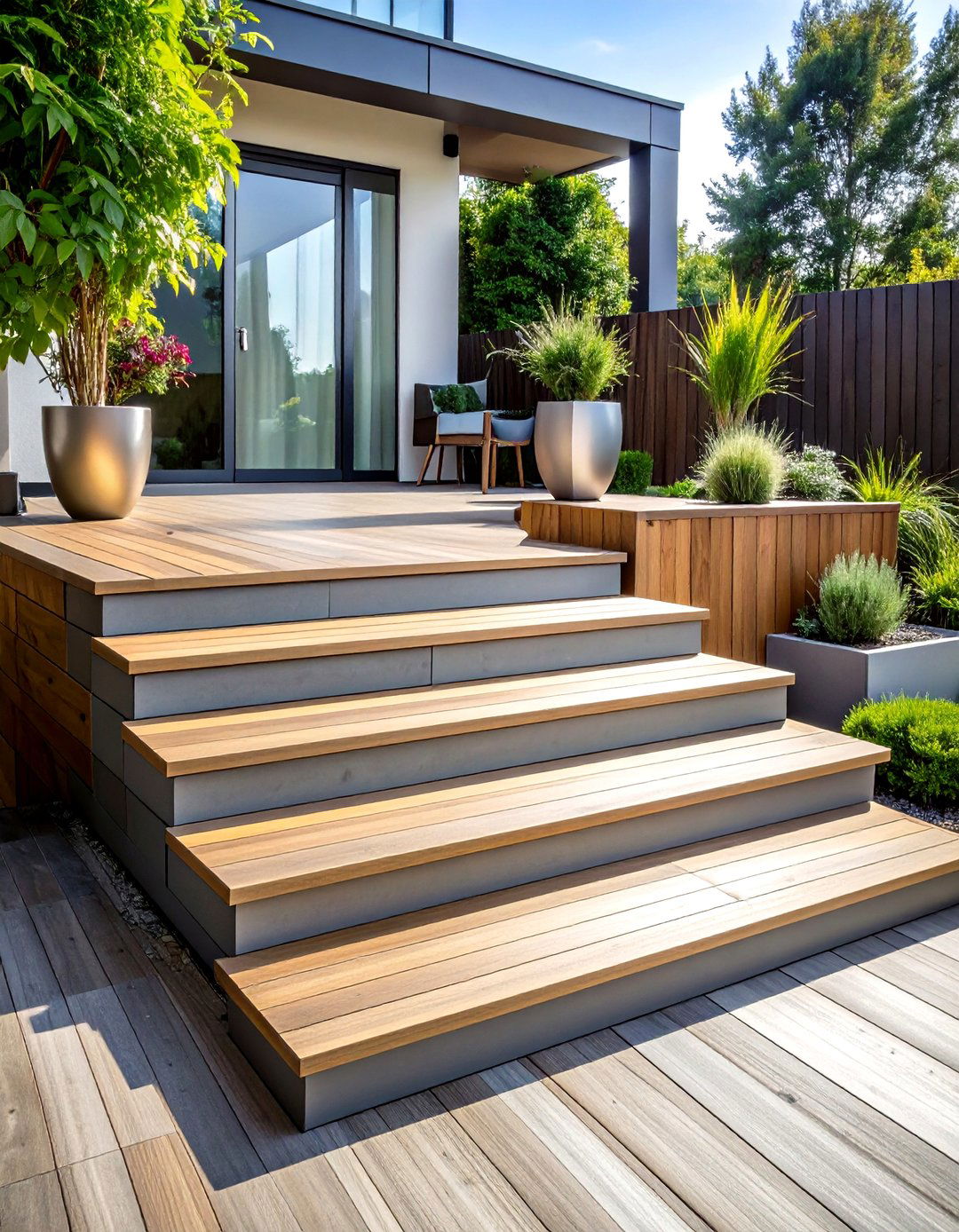
Mixed material patio steps combine different elements to create unique, custom designs that reflect personal style and architectural themes. Popular combinations include steel risers with wood treads, concrete steps with steel handrails, or stone treads with metal accents. The contrast between materials creates visual interest and can help tie together different design elements in the landscape. Steel provides strength and modern appeal, while wood adds warmth and natural texture. Proper treatment and maintenance of each material ensures longevity, and the combination allows for creative expressions that standard single-material steps cannot achieve.
12. Boulder Patio Steps with Natural Stone Placement
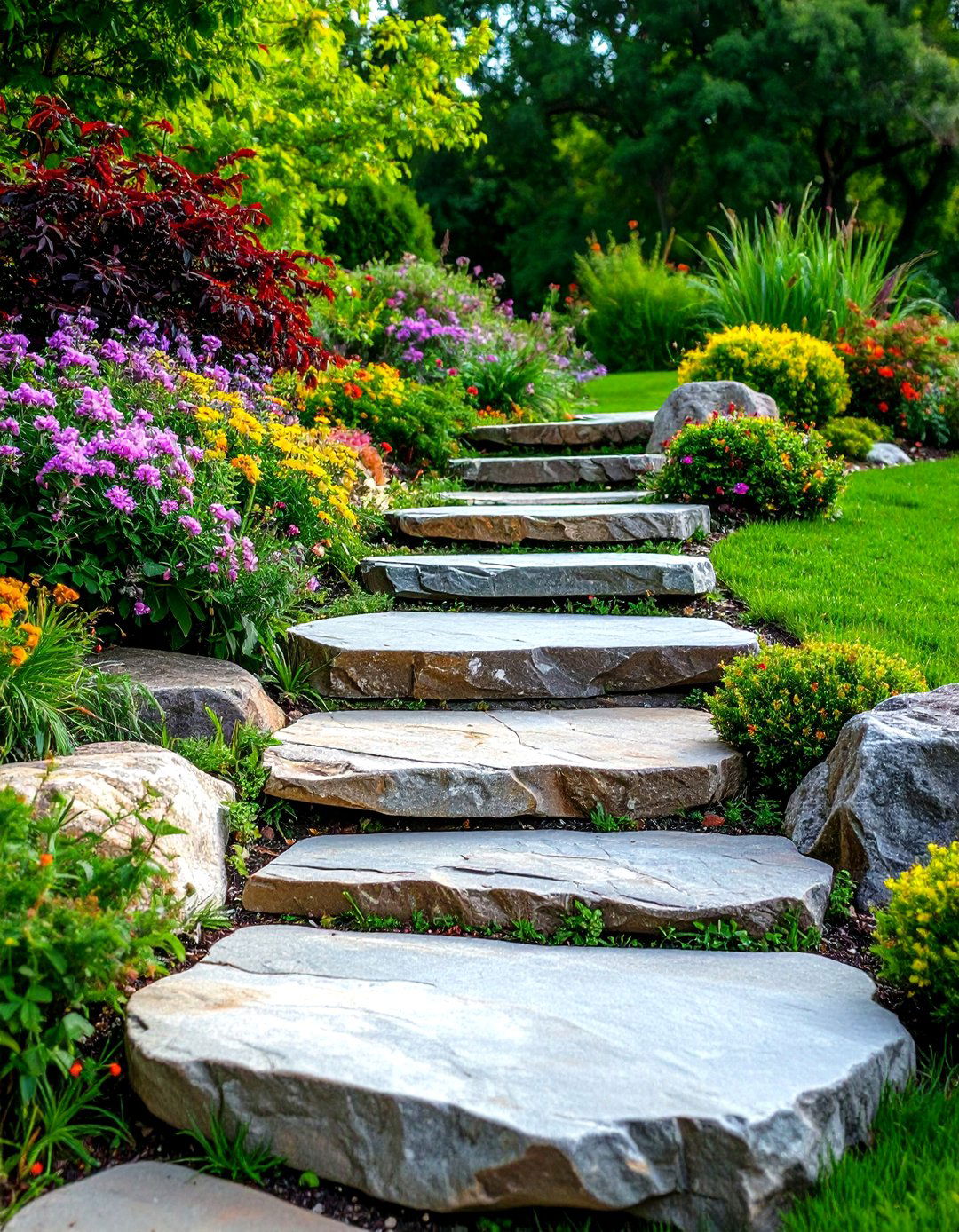
Boulder patio steps create a rustic, organic approach that feels like a natural part of the landscape. Large, flat boulders are carefully selected and positioned to create stable stepping surfaces that follow the natural contours of the slope. The irregular shapes and varying sizes of boulders add character and visual interest while creating a connection with nature. Gaps between boulders can be filled with smaller stones, gravel, or planted with low-growing groundcovers. This approach works particularly well in naturalistic gardens, woodland settings, or contemporary landscapes seeking an organic contrast to architectural elements.
13. Stamped Concrete Patio Steps with Textured Patterns

Stamped concrete patio steps offer the appearance of natural materials at a more affordable cost, with endless design possibilities through color and texture options. The concrete can be stamped to mimic slate, stone, brick, or even wood grain patterns, while integral color provides consistent, fade-resistant hues. Textured surfaces improve slip resistance and add visual interest. This construction method allows for custom shapes and integrated features like planters or seating areas. Proper sealing protects the surface from weather and staining, while the monolithic construction eliminates joints that could shift or settle over time.
14. Raised Platform Patio Steps with Storage Integration
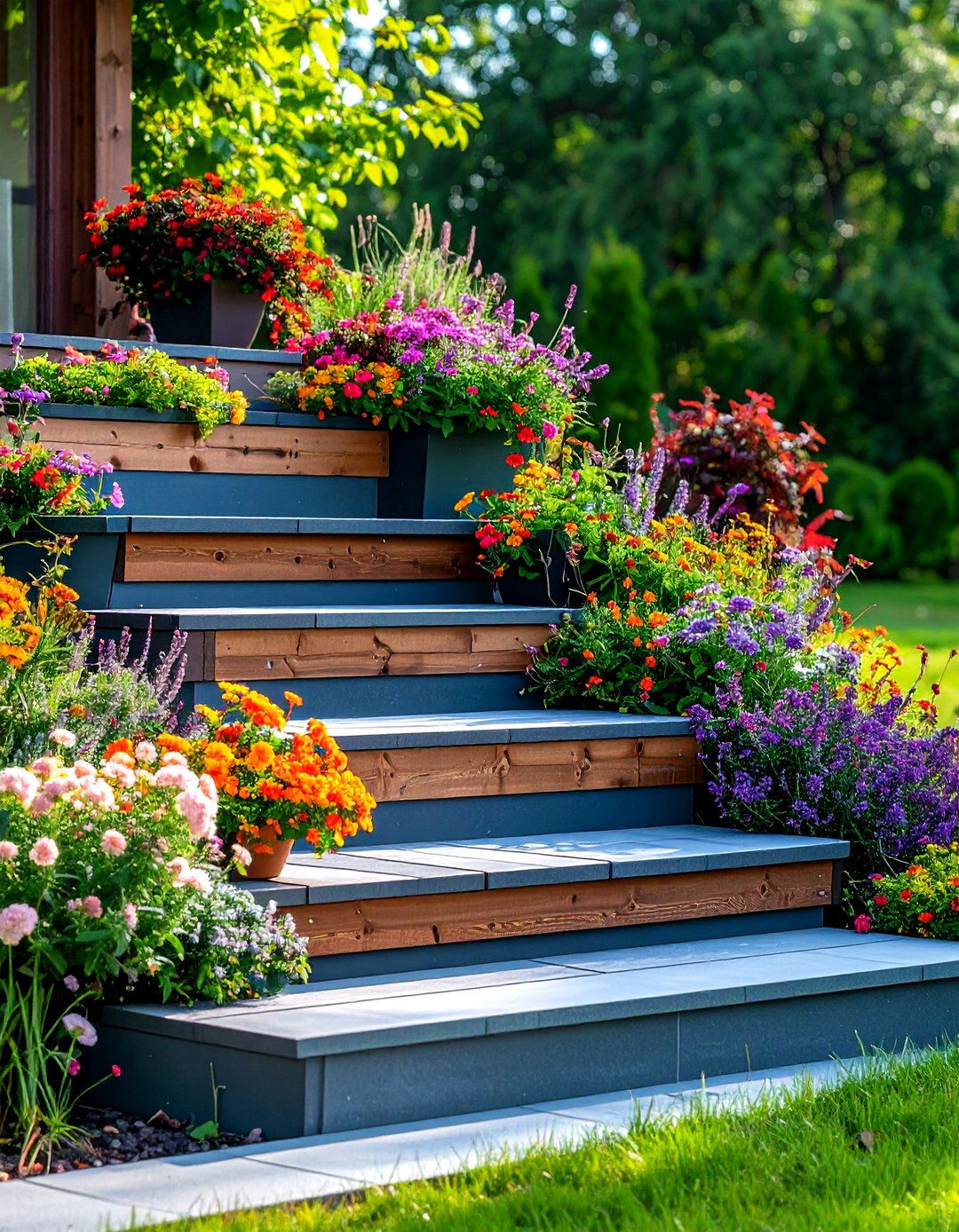
Raised platform patio steps create multi-level outdoor living spaces while incorporating hidden storage for cushions, garden tools, or seasonal items. The platform design allows for furniture placement and entertaining areas at different levels, effectively expanding usable space. Storage compartments can be built into the structure with weather-resistant materials and proper drainage. This approach works particularly well for smaller yards where every square foot counts, or for creating distinct zones within larger outdoor spaces. The raised platform also improves drainage and can help level uneven terrain.
15. Spiral Patio Steps with Curved Handrails
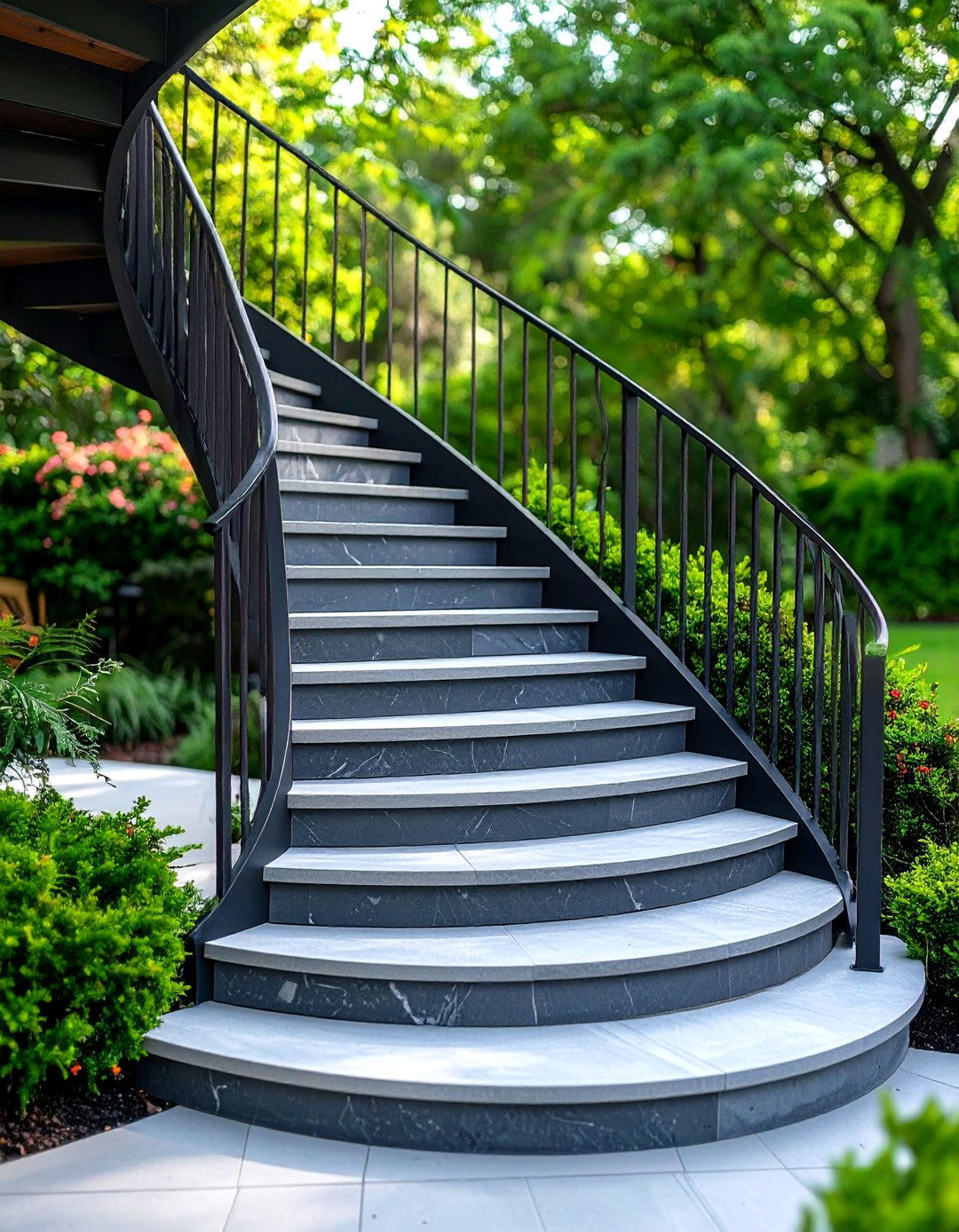
Spiral patio steps create a dramatic focal point while efficiently managing elevation changes in compact spaces. The curved design adds architectural interest and creates a sense of movement through the landscape. Matching curved handrails ensure safety while maintaining the flowing aesthetic. This design requires careful engineering and skilled construction, particularly for the curved formwork and railing attachment points. The spiral shape can be adapted to various radii depending on space constraints and desired impact. This approach works beautifully in contemporary settings or as a contrast element in traditional gardens.
16. Travertine Patio Steps with Tumbled Finish
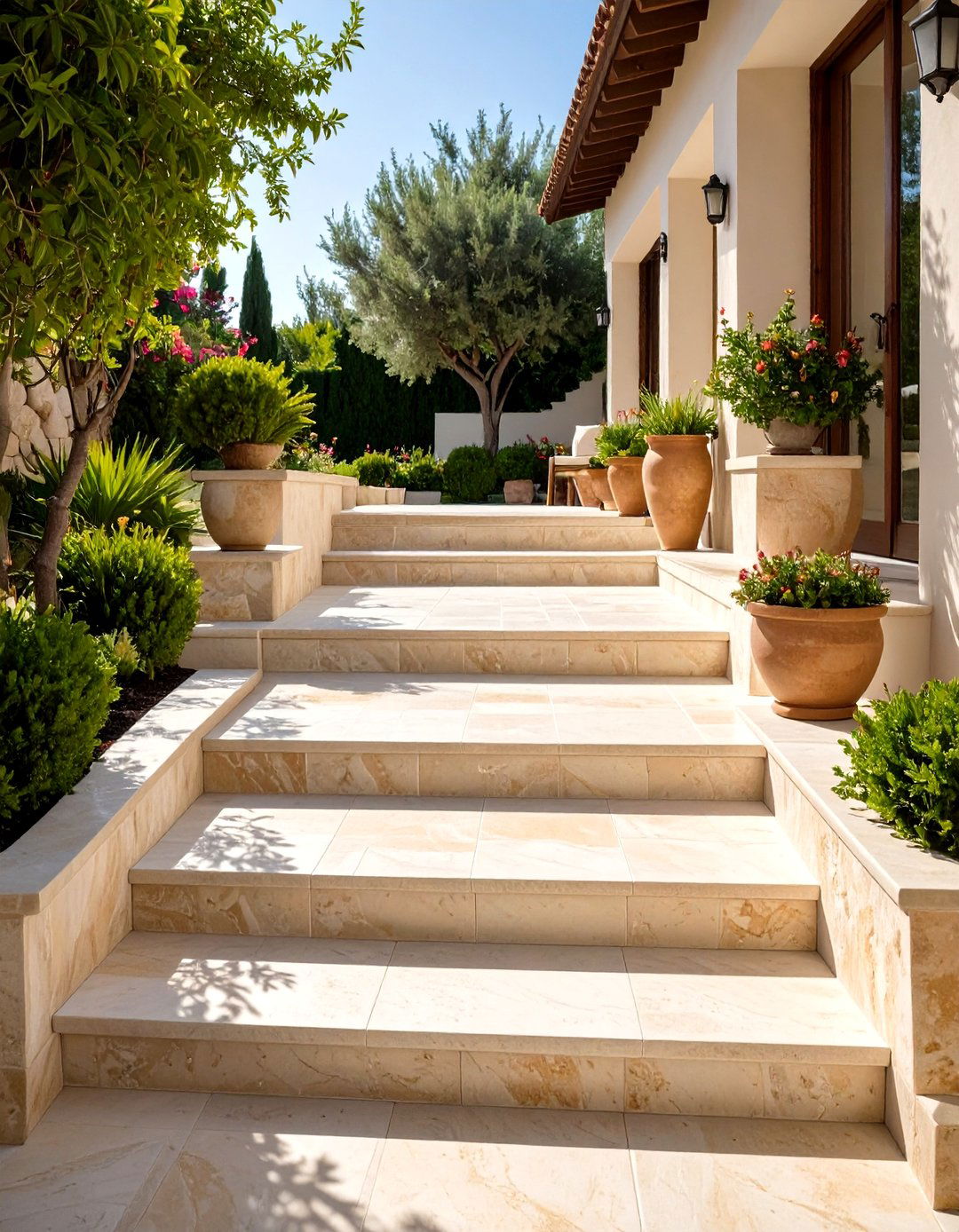
Travertine patio steps bring Mediterranean elegance to outdoor spaces with their warm, neutral tones and natural beauty. The tumbled finish creates a weathered, old-world appearance while providing slip resistance and hiding minor imperfections. Travertine's natural porosity requires proper sealing in freeze-thaw climates, but its beauty and durability make it worth the maintenance. The stone's light colors help reflect heat, making it more comfortable underfoot in sunny locations. Natural variations in color and texture ensure each installation is unique, while the stone's ability to be cut and shaped allows for custom designs.
17. Patio Steps with Water Feature Integration
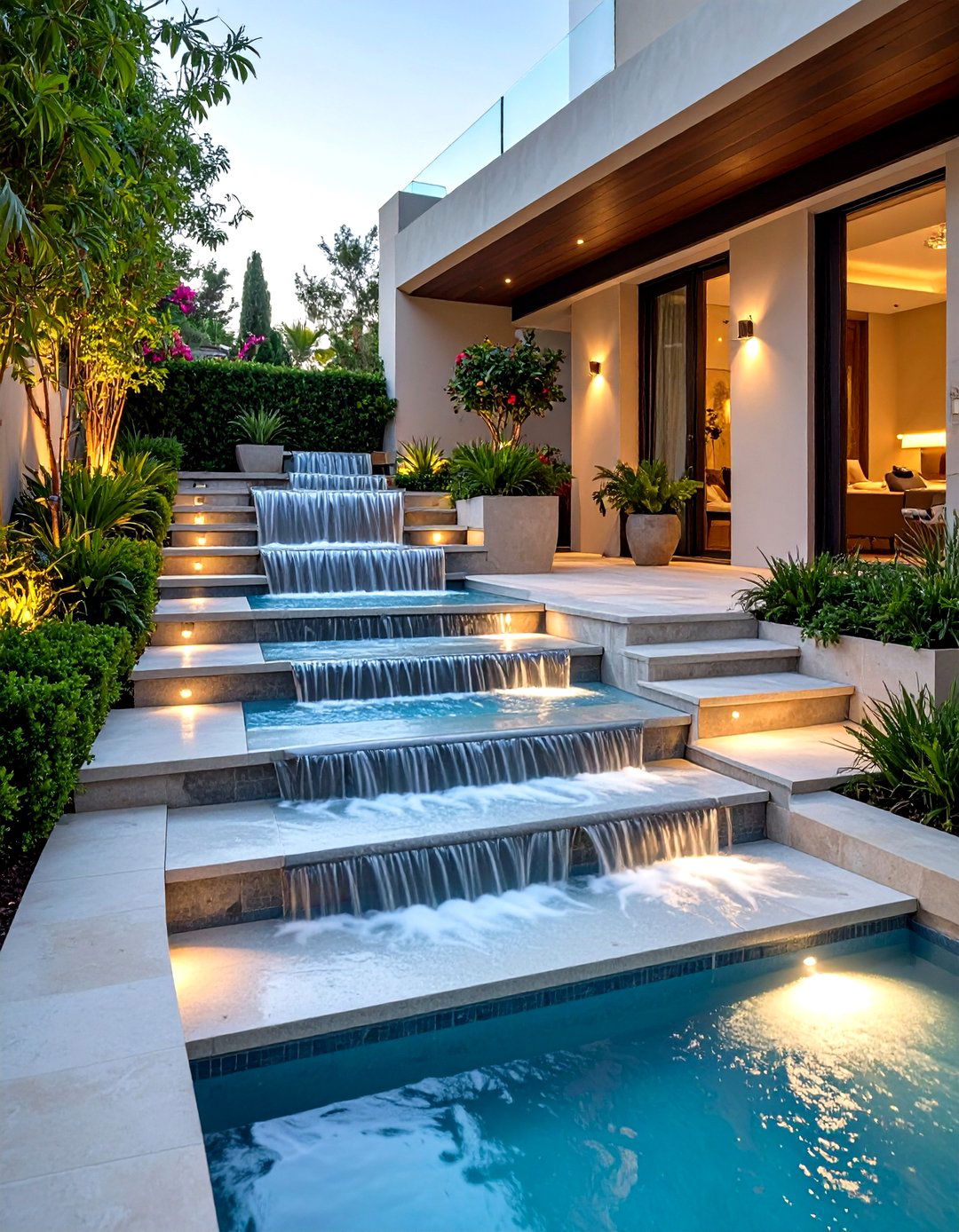
Patio steps with integrated water features create a luxurious, spa-like atmosphere through the soothing sounds and cooling effects of moving water. Water can cascade down the step faces, flow alongside the steps in channels, or emerge from fountains integrated into landings. Proper drainage and waterproofing are essential for long-term success, along with appropriate pump sizing and filtration systems. The water element helps mask traffic noise and creates a focal point that draws the eye upward through the landscape. This design works particularly well in formal gardens or contemporary settings where the water feature becomes a sculptural element.
18. Composite Deck Patio Steps with Cable Railing
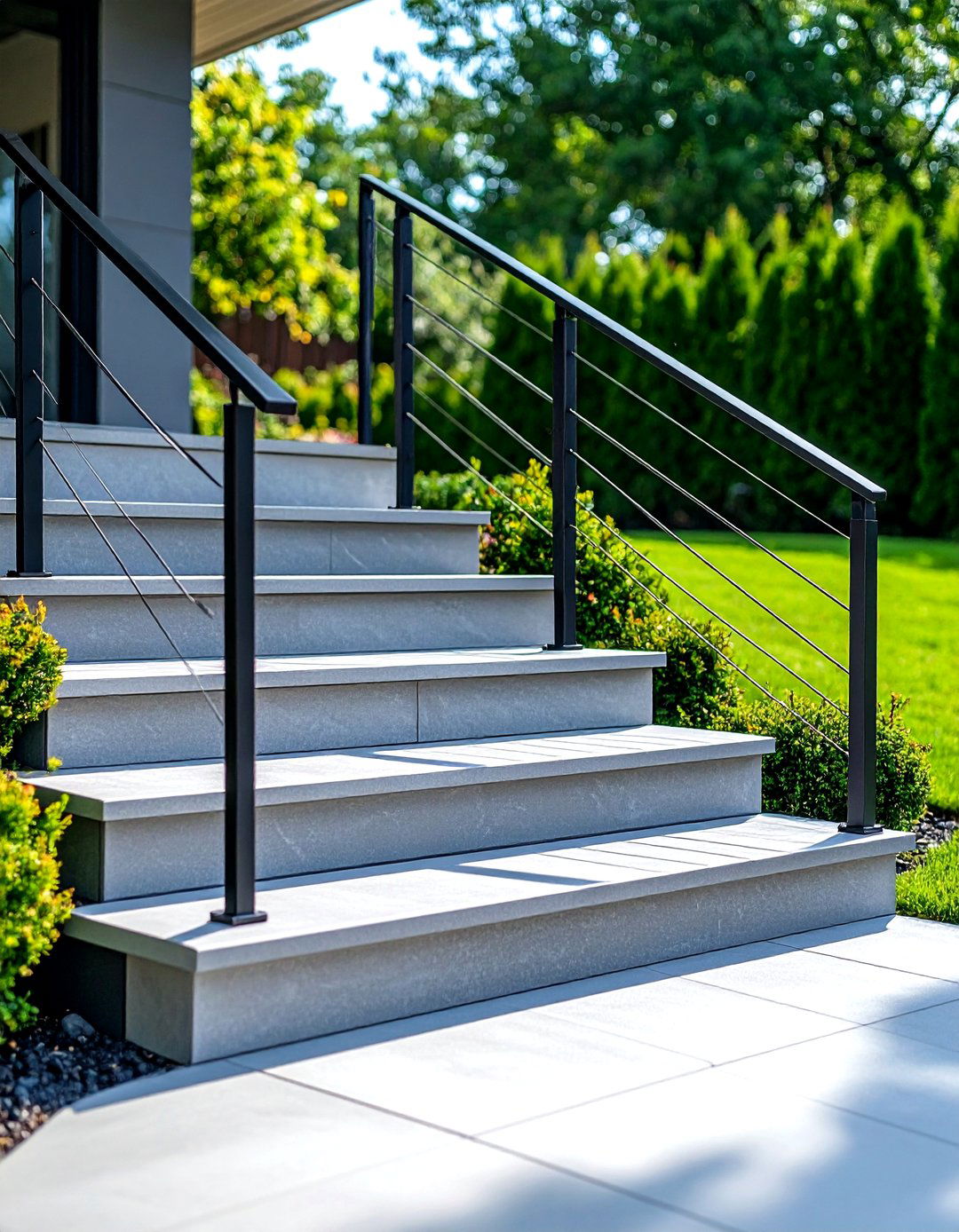
Composite deck patio steps offer low-maintenance durability with the warm appearance of wood, while cable railing provides modern, unobtrusive safety features. Composite materials resist fading, staining, and weathering while offering consistent color and texture. The cable railing system maintains clear sightlines and doesn't compete visually with the landscape. This combination works well for contemporary homes and creates a seamless transition between indoor and outdoor living spaces. The composite material can be curved for flowing designs, and the cable system can be integrated with lighting for enhanced safety and ambiance.
19. Fieldstone Patio Steps with Mortar Joints
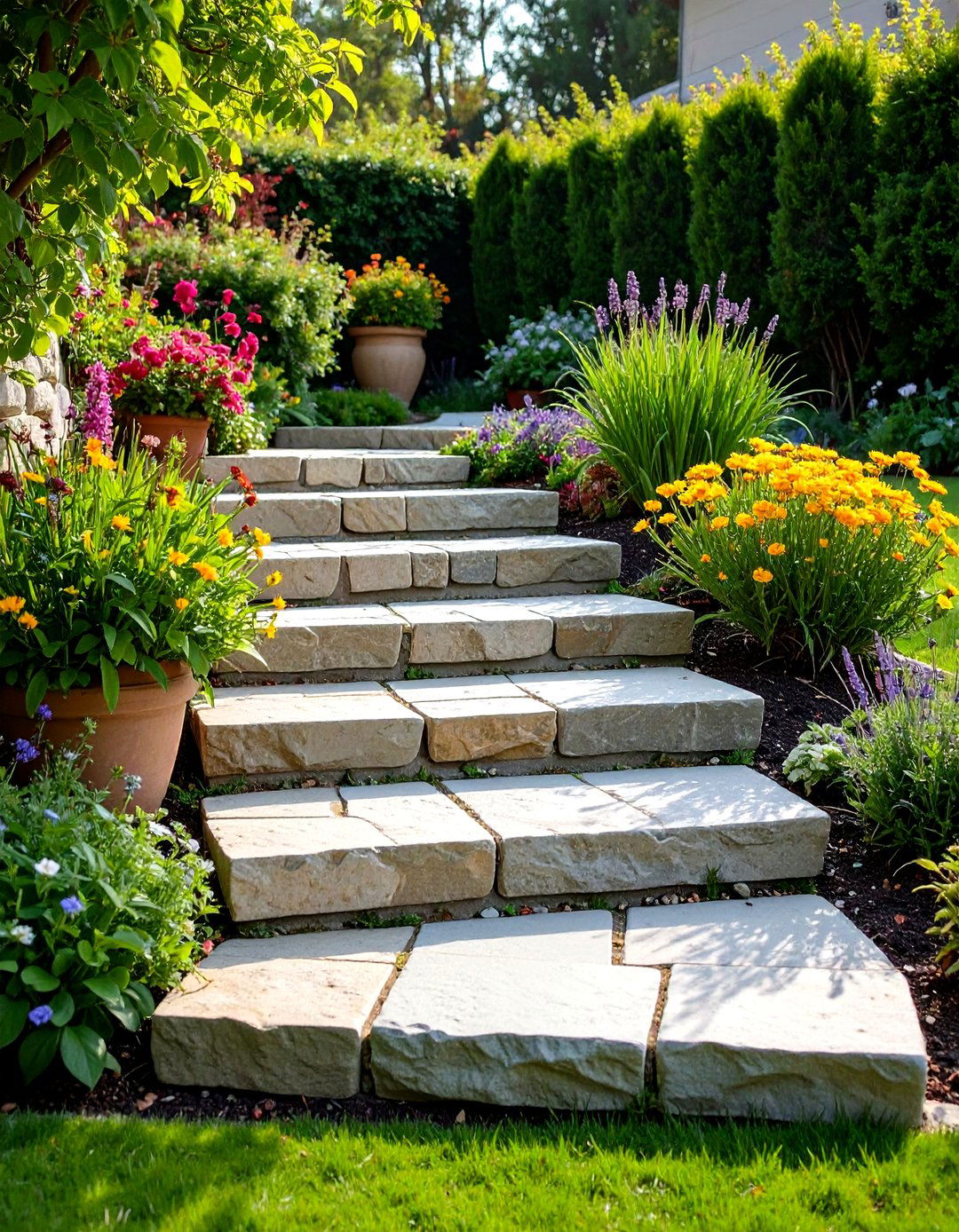
Fieldstone patio steps celebrate natural materials with their irregular shapes, varied colors, and rustic character. Each stone is unique, creating steps that feel like they've been part of the landscape for generations. Mortar joints provide stability while allowing for the natural variations in stone thickness and shape. The earthy colors and textures of fieldstone complement natural gardens and traditional architecture beautifully. Proper drainage behind the stones prevents frost damage, while the natural slip resistance of most fieldstones provides safe footing. This approach requires skilled stonemasons but creates truly unique, artistic installations.
20. Porcelain Tile Patio Steps with Modern Minimalism
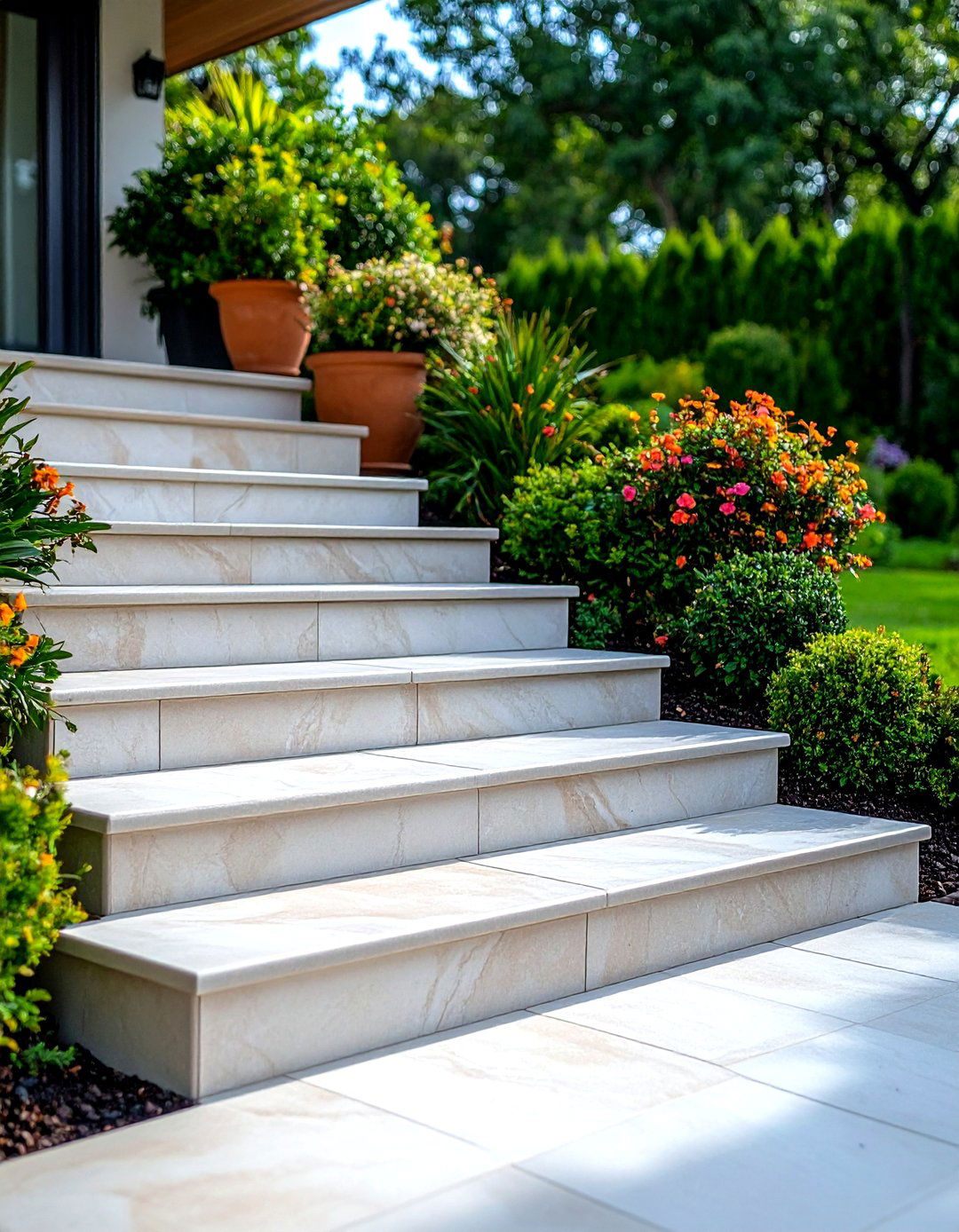
Porcelain tile patio steps represent the cutting edge of outdoor material technology, offering exceptional durability, consistent appearance, and minimal maintenance requirements. Large-format tiles create clean, uninterrupted surfaces that emphasize horizontal lines and modern aesthetics. The tiles can mimic natural stone, wood, or concrete textures while providing superior stain resistance and freeze-thaw stability. Proper installation with appropriate adhesives and joint systems ensures long-term performance. This approach works beautifully in contemporary settings where clean lines and minimal maintenance are priorities, and the consistent appearance creates a sophisticated, high-end look.
Conclusion:
Choosing the right patio steps involves balancing aesthetics, functionality, and budget considerations while ensuring the design complements your home's architecture and landscape style. From natural stone's timeless appeal to modern composite materials' low-maintenance convenience, each option offers unique benefits. Consider factors like climate, maintenance requirements, and intended use when making your selection. Professional installation ensures proper drainage, structural integrity, and long-term performance, making your investment in beautiful patio steps a lasting enhancement to your outdoor living space.




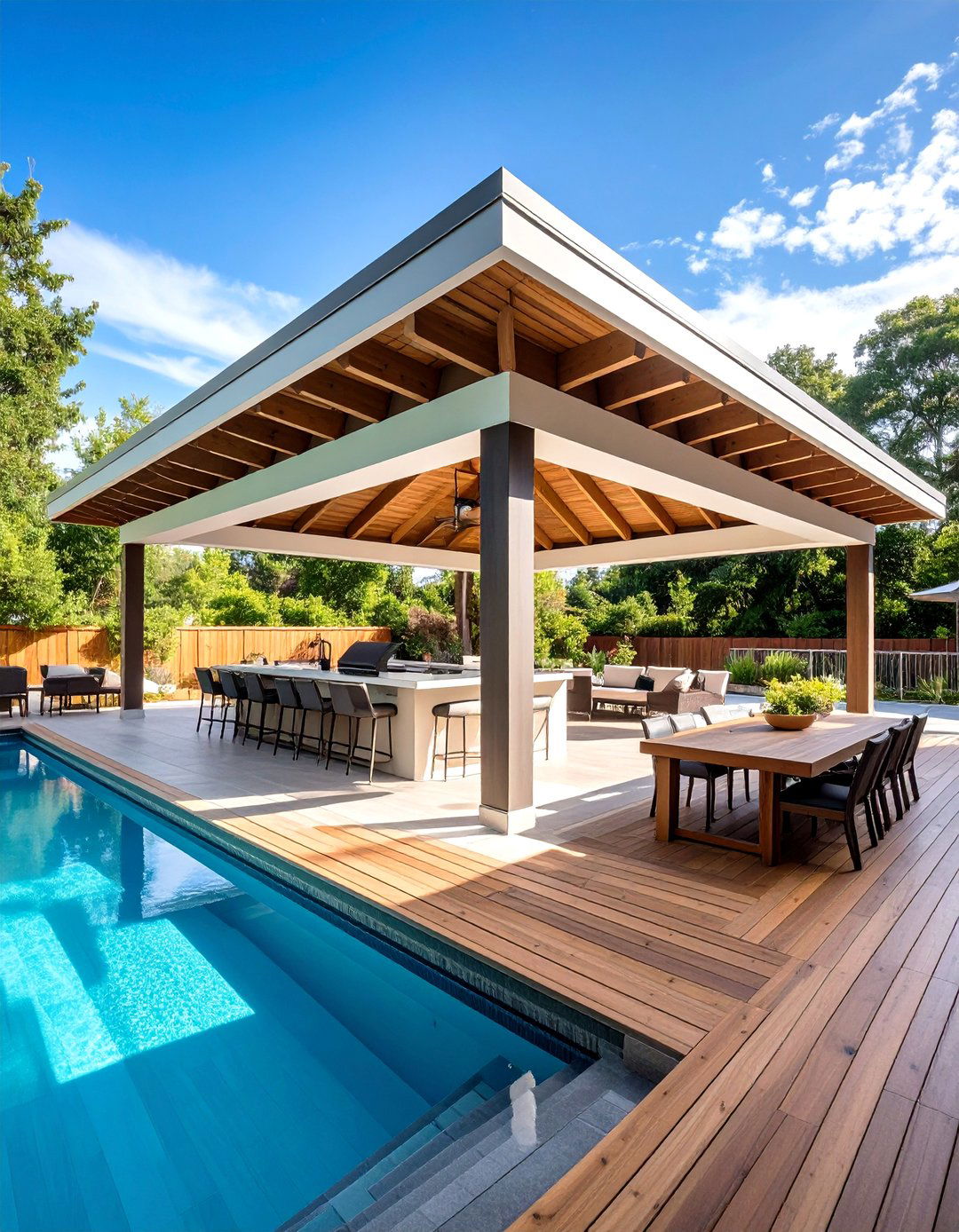



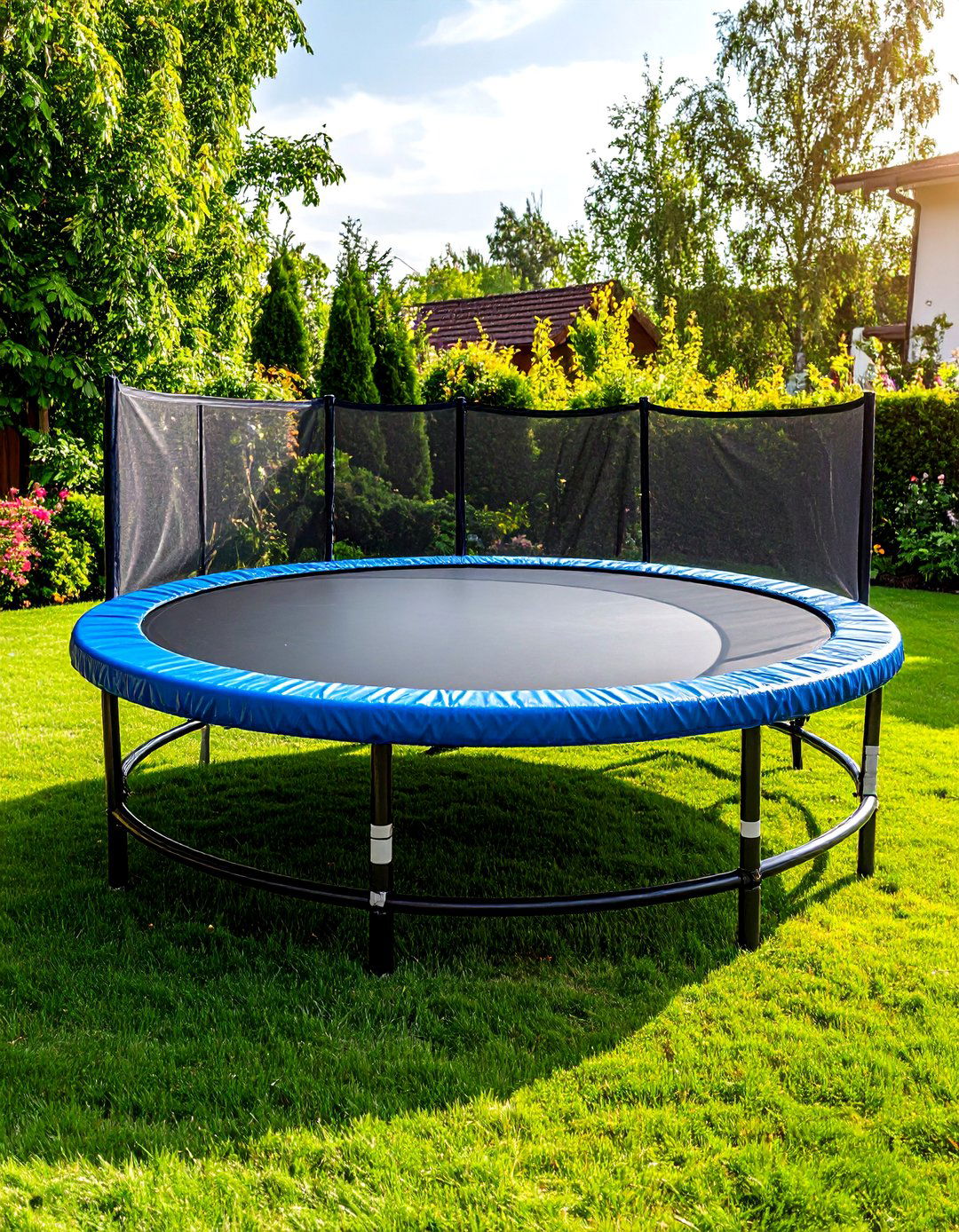
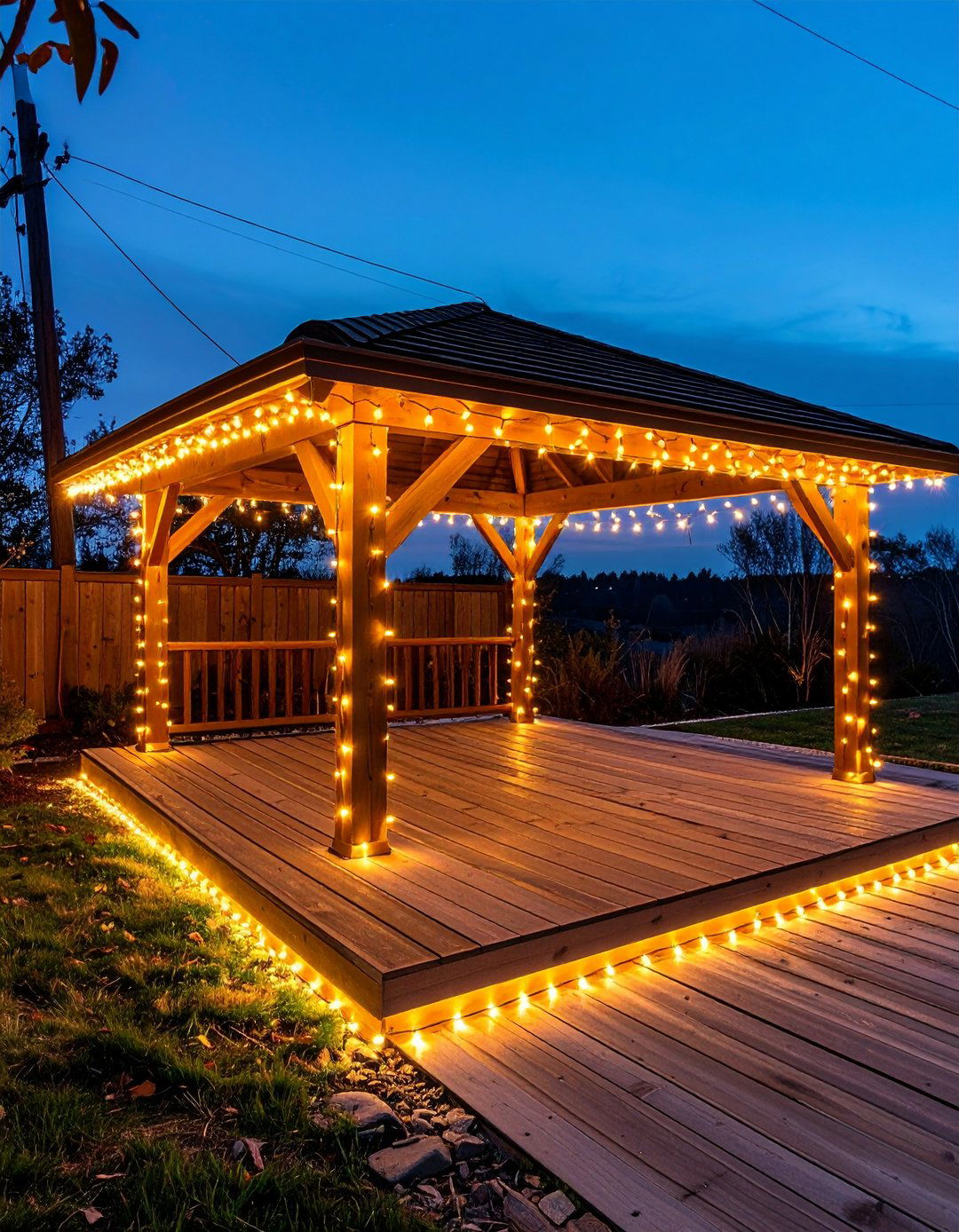
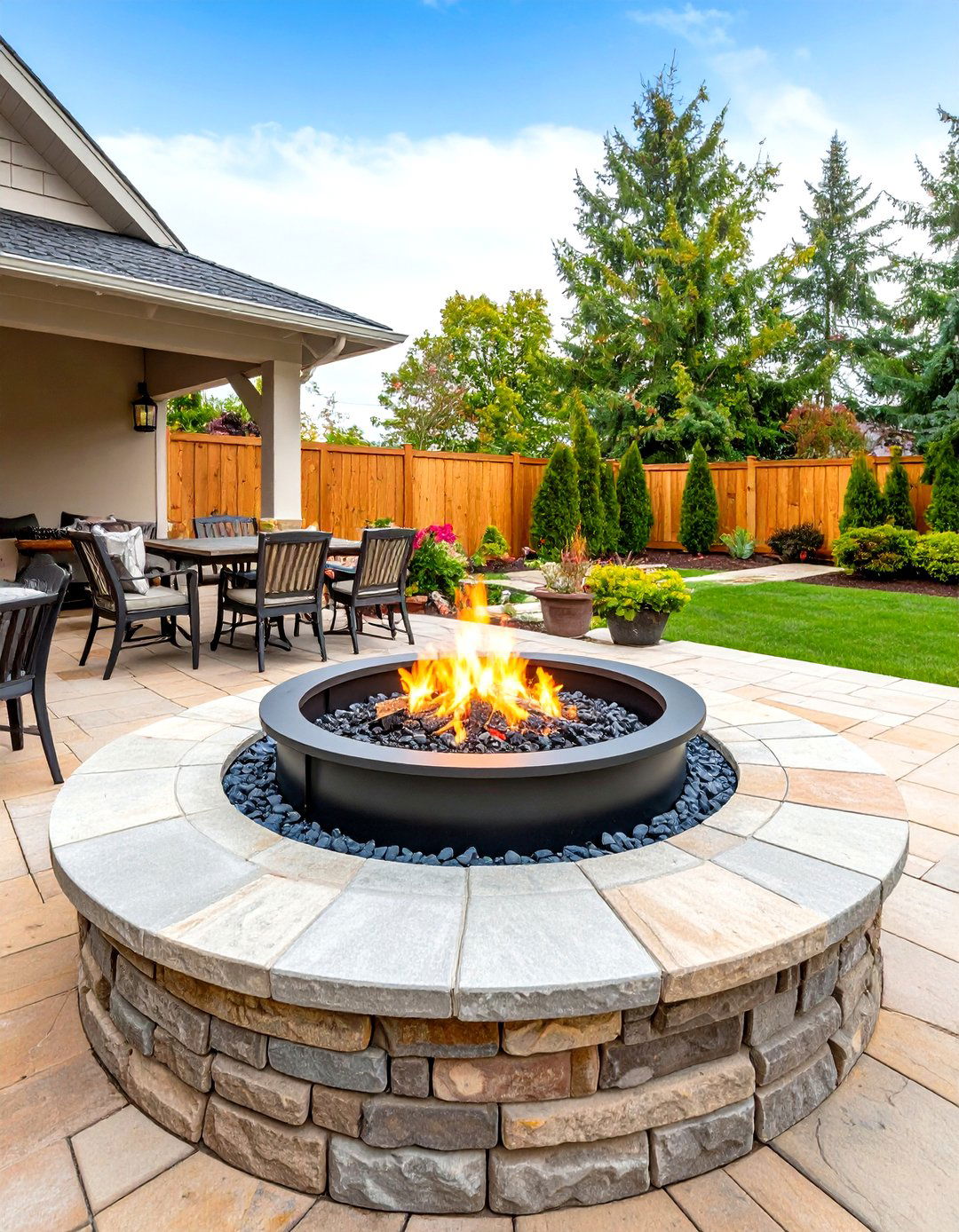
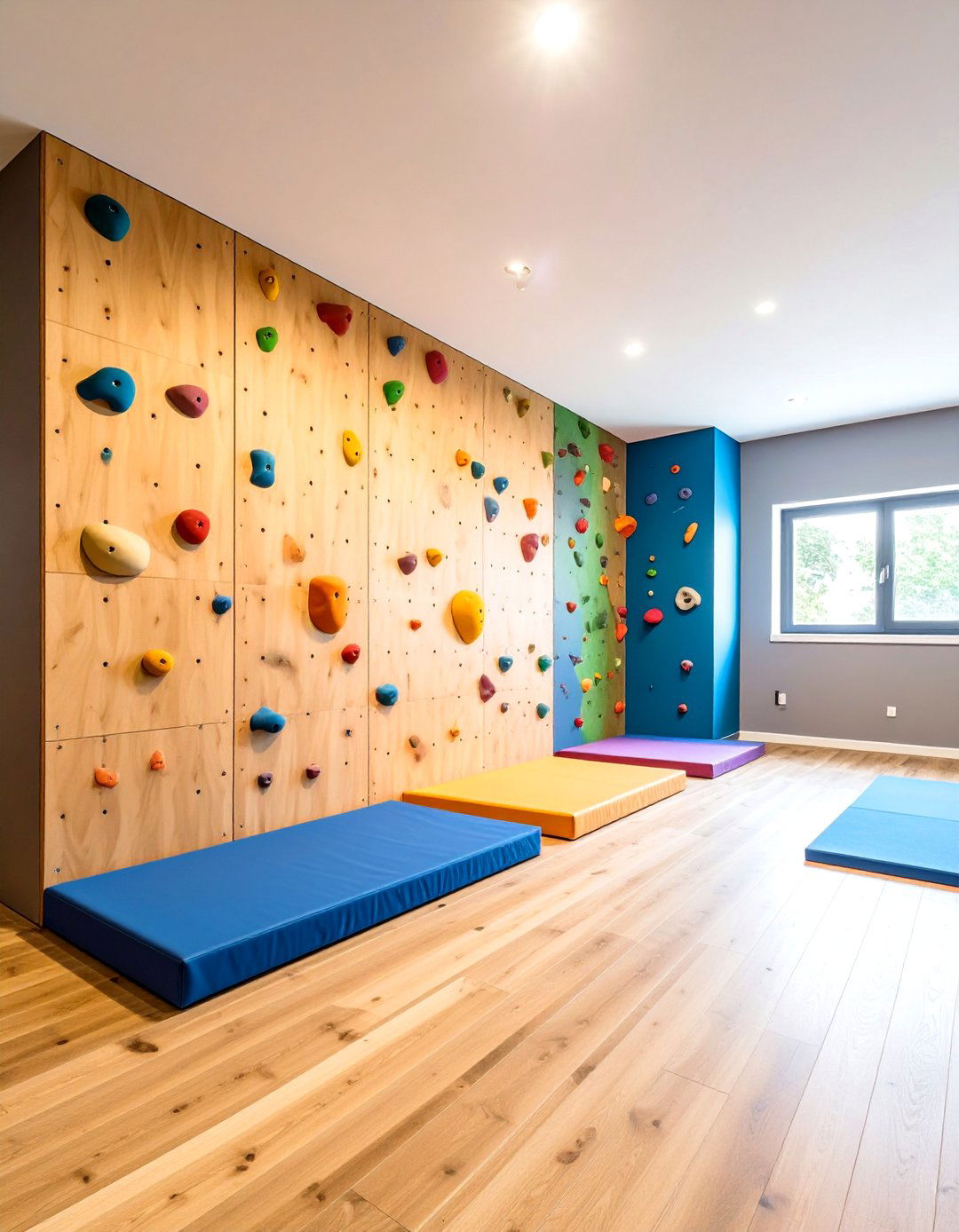

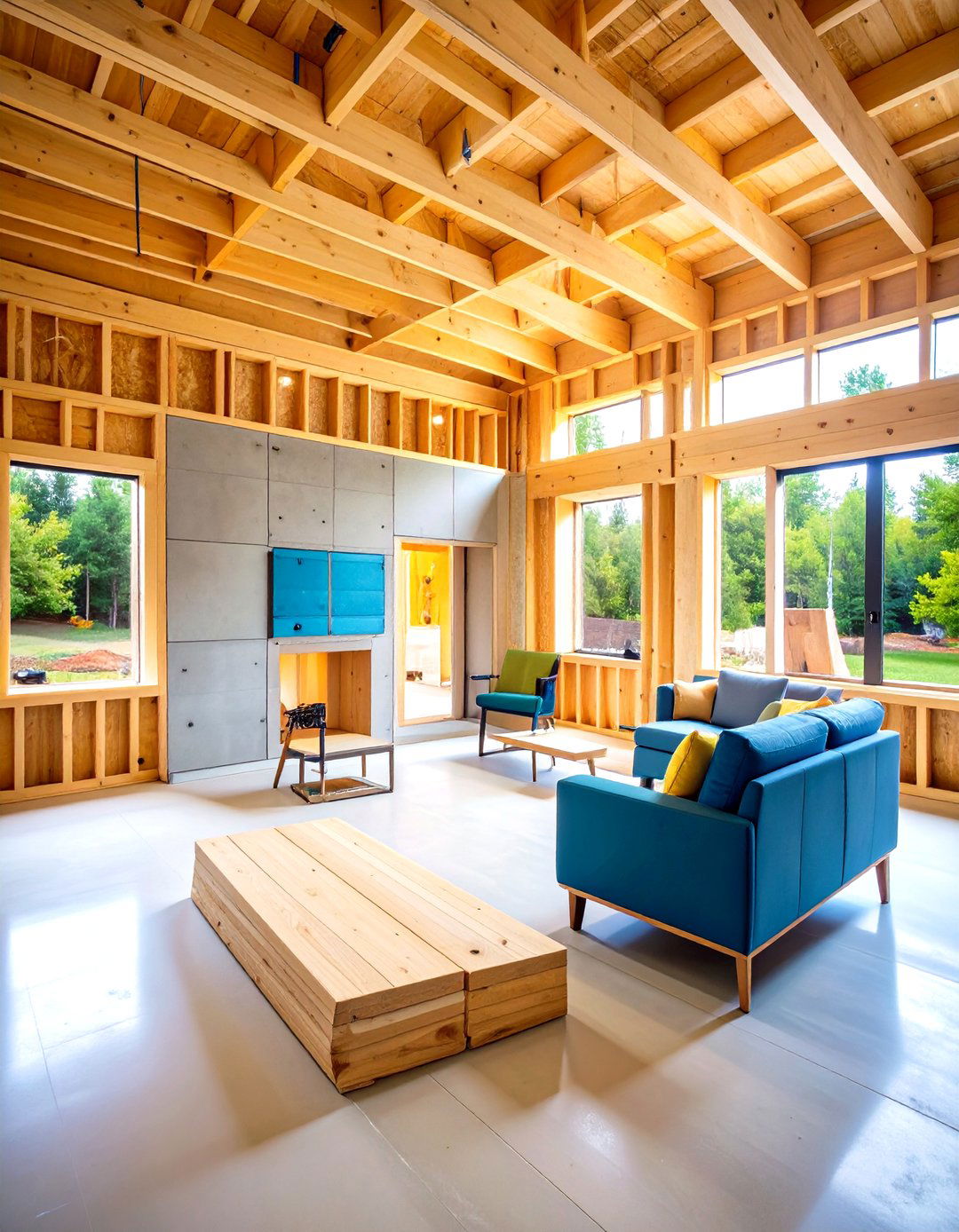

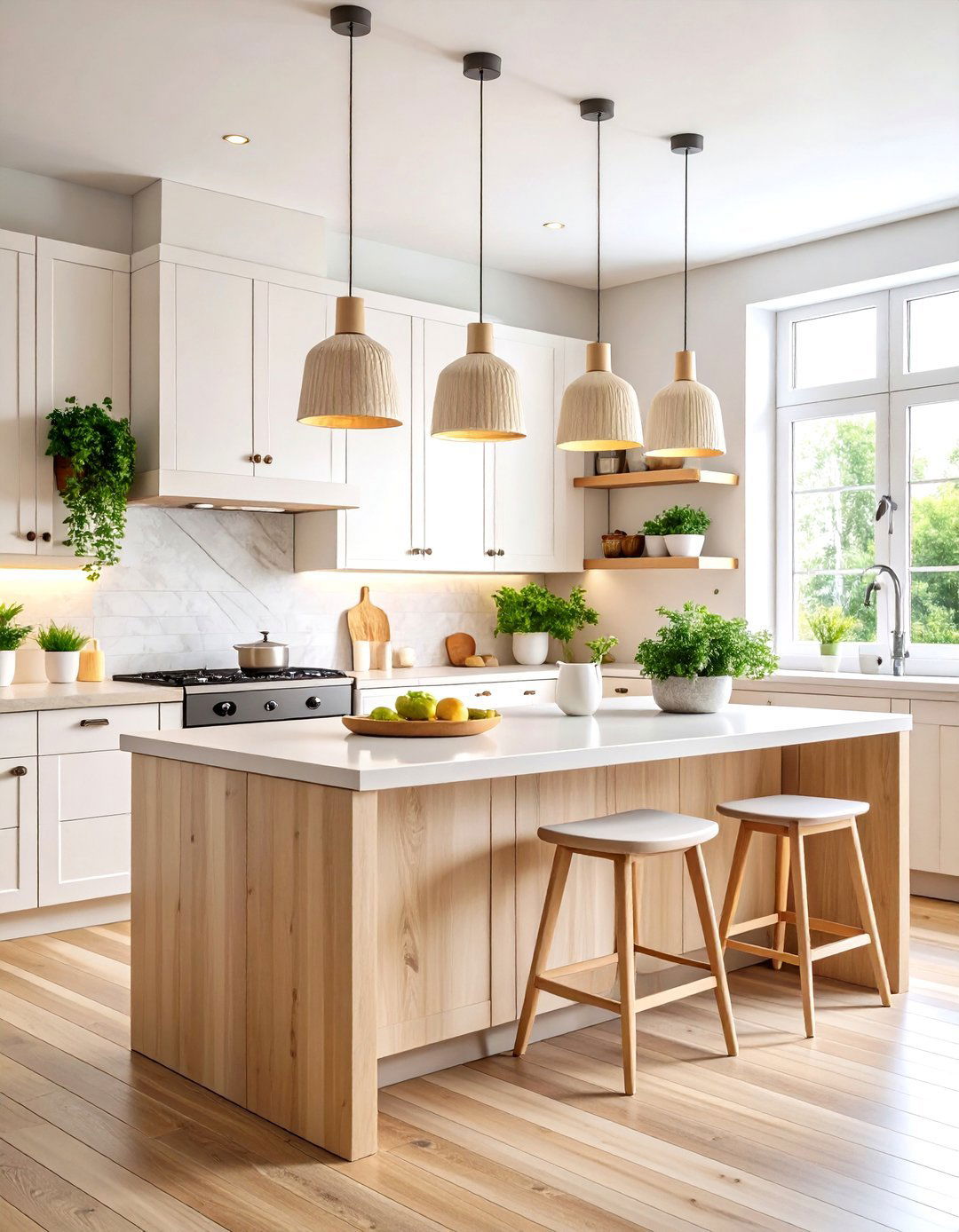
Leave a Reply